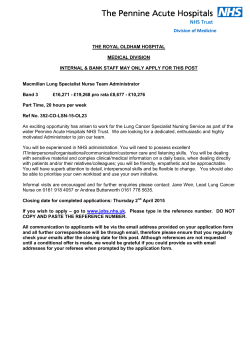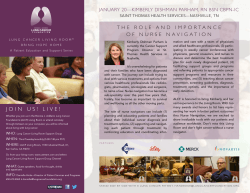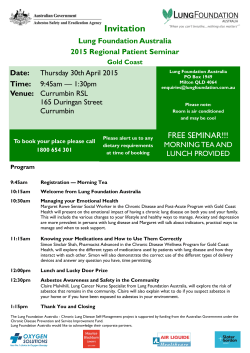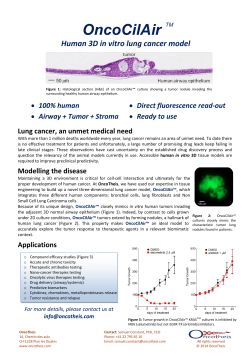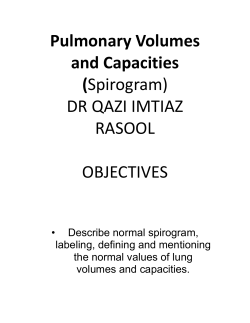
Black Lung Disease - Advance Nursing Institute (ANI)
Pneumonoultramicroscopicsilicovolcanoconiosis (Black Lung Disease) How to Receive Your CE Credits Read your selected course Completed the quiz at the end of the course with a 70% or greater. Complete the evaluation for your selected course. Print your Certificate CE’s will automatically be reported to the CE Broker Purpose The purpose of this continuing education course is to educate health care worker on the prevalence of Pneumonoultramicroscopicsilicovolcanoconiosis (Black Lung Disease). Black lung disease was almost extinct during the early 1990’s. Currently there is an increase of black lung disease caused by the inhalation of certain types of dusts (coal mine dust, or silica dust) and the lung tissue’s reaction to the dust. The primary cause of the black lung disease is work-place exposure (CDC, 2012). Objectives 1. Discuss the prevalence of black lung disease. 2. Describe the pathophysiology of black lung disease 3. List the causes of black lung disease Author: Denise R. Eccles, PhD, ED, RN Advance Nursing Institute INC is approved as a provider for continuing education by Florida Board of Nursing. Provider # 50-16977 Copyright © 2013 Advance Nursing Institute INC 1 4. Describe the sign and symptoms of lung disease 5. List Diagnostic testing for black lung disease 6. Discuss treatment options for black lung disease 7. Understand the Education and the prevention of black lung disease 8. Describe the surveillance programs by Occupational Safety and Health Administration, and National Institute for Occupational Safety and Health. Background Pneumonoultramicroscopicsilicovolcanoconiosis (Black Lung Disease) is a term used to describe a disease that is caused by cold miners inhaling too much coal mine dust, silica dust, or quartz dust. Black Lung Disease is lung disease known as silicosis. Black Lung Disease was nearly eradicated in the 1990’s, and now the disease is back with a vengeance (Black Lung Disease Numbers Soar, 2014). According to the CDC, (2012) the prevalence of black lung disease decreased 90% during years 1969 to 1995 following the enactment of the Coal Mine Health and Safety Act. Currently the prevalence of black lung cases in the United States has more than doubled. Data from the National Institute for Occupational Safety and Health (NIOSH) indicates that in 2012, the worst form of the disease was showing up at a level not seen since the early 1970s. NIOSH determined that despite readily available dust control technology, mine workers following OSHA recommendations for best practices for dust control in coal mining, recent findings suggest dust exposures have not been adequately controlled and that a substantial portion of U.S. coal miners continue to develop black lung disease associated progressive Author: Denise R. Eccles, PhD, ED, RN Advance Nursing Institute INC is approved as a provider for continuing education by Florida Board of Nursing. Provider # 50-16977 Copyright © 2013 Advance Nursing Institute INC 2 massive fibrosis (PMF) (CDC, 2012). Black lung disease is an advance and lethal form of black lung with no cure and limited treatment options. NIOSH researchers note that excessive inhalation of coal mine dust is the sole cause of death among cold miners. Each year black lung disease related pneumoconiosis kills over 1000 miners in the United States (CDC, 2008). Causes Black lung disease, is caused by inhaling coal mine dust, silica dust, or quartz dust. When an individual inhales these type of dust particles, the dust passes through the alveoli of the lungs into the blood stream. The results of the dust being released into the blood stream causes the white blood cells to release a peptide, protein and a glycoprotein called cytokines. According to Mandel, (2013) cytokines are cell signaling molecules that aid in cell to cell communication in an immune response that stimulates the movement of cells towards sites of inflammation, trauma, and infection resulting in the stimulation of fibroblast. Fibroblast stimulation leads to fibrosis. Fibrosis leads to fibrotic disease that results in excessive scarring of the lungs due to production, deposition, and contraction of extracellular matrix (Leask, and Abraham, 2004). Gurvan, et al. (2010) illustrates that extracellular matrix is a collection of extracellular molecules secreted by cells that provides structural support to the surrounding cells. The fibrosis causes inflammation of the walls in the air sacs of the lungs. The lungs then becomes stiff from scarring of the tissue between the air sacs. According to the American Lung Association (2015) people who inhale coal dust may not have any symptoms for many years. However, over time as the coal dust has settled deep in the lung, it eventually causes Author: Denise R. Eccles, PhD, ED, RN Advance Nursing Institute INC is approved as a provider for continuing education by Florida Board of Nursing. Provider # 50-16977 Copyright © 2013 Advance Nursing Institute INC 3 the lung to harden. As the lung hardens, breathing becomes more difficult and gets worse over time. Sign and Symptoms The key is to recognize the signs and symptoms of black lung disease early and to take the necessary precautions to reduce or eliminated future or any additional exposures (CDC, 2008). NIOSH operates a surveillance program called the Coal Workers Health Surveillance Program. This program allows Coal Miners access to a no cost health evaluations (including a chest x-ray) once every five years. According to the CDC, (2008) the chest x-rays can detect the early signs of coal workers’ pneumoconiosis and can detect lung changes often before the miner is aware of any breathing problems. The CDC, (2008) further illustrates that the programs are meant to protect the health of the miners only if they participate. The symptoms of Black lung disease are as follows: Tachypnea Chronic cough Shortness of breath Anorexia Hoarseness Increased susceptibility to pulmonary tuberculosis When the black lung disease progresses the symptoms may take on a difference appearance. Therefore it is important to perform a thorough assessment. Additional symptoms include but are not limited to: Author: Denise R. Eccles, PhD, ED, RN Advance Nursing Institute INC is approved as a provider for continuing education by Florida Board of Nursing. Provider # 50-16977 Copyright © 2013 Advance Nursing Institute INC 4 Lung edema Swollen Lymph Nodes Pleural Effusion Respiratory Failure Lung Cancer COPD Diagnosing Black Lung Disease The diagnosis of black lung disease for a coal miner can be screen by the NIOSH Coal Workers Health Surveillance Program. Individual who are exposed to coal, quartz, or silica dust may not be diagnosed until disease has exacerbated. The diagnosis of black lung disease can be screen by the following exams: Chest X-rays Occupational history Pulmonary function test Treatment Treatment options are aimed at prevention. Because there is no treatable or curable for black lung disease. How severe each person's disease becomes is the result of the conditions of his or her work during exposure to coal dust (The American Lung Association, 2015). Nonetheless treatment options are aimed at treating the symptoms and complications of the disease to lessen breathing difficulties. Some treatment option are similar to those treatment option of individuals diagnosed with chronic lung diseases for example: Author: Denise R. Eccles, PhD, ED, RN Advance Nursing Institute INC is approved as a provider for continuing education by Florida Board of Nursing. Provider # 50-16977 Copyright © 2013 Advance Nursing Institute INC 5 1. Titrated oxygen therapy (monitor patient for decompensation) 2. Invasive mechanical ventilation 3. Inhaled short-acting bronchodilators include beta agonists for example: a. Albuterol b. Levalbuterol (Xopenex) c. Anti-cholinergics d. Ipratropium (Atrovent) (Rabe et al., 2007; McCrory, Brown, Gelfand, and Bach (2001). Short acting bronchodilators improve dyspnea and activity tolerance. Additional treatment option may include systemic corticosteroids that will also aid in the improvement of hypoxemia and forced expiratory volume in one second (FEV1) (Rabe et al., 2007; Decramer, 2008; Singh, Palda, Stanbrook, and Chapman, 2002). Nonetheless the American Lung Association, 2015 illustrates that medical management is geared at treating the symptoms and complications of the disease to lessen breathing difficulties. Prevention and Education The only way to prevent black lung disease is to use the standard protective requirement mandated by the Occupational Safety and Health Administration (OSHA) is by not inhaling coal dust. According to Center for Disease Control and Prevention, (2012) the Occupational Safety and Health Administration (OSHA) (part of the U.S. Department of Labor) sets standards for workers. The standards include protective requirements for anyone who works around coal, graphite, or man-made carbon. The standards mandate that all workers should wear a mask to Author: Denise R. Eccles, PhD, ED, RN Advance Nursing Institute INC is approved as a provider for continuing education by Florida Board of Nursing. Provider # 50-16977 Copyright © 2013 Advance Nursing Institute INC 6 help prevent black lung disease and follow other personal safety procedures if they are exposed. Worker should be educated to follow the following procedures to protect themselves for coal dust exposure. According to Center for Disease Control and Prevention, (2012) exposed workers should: a. If coal dust contacts the skin, workers should wash the affected areas with soap and water. b. If your clothing is contaminated with coal dust, remove it immediately. (Employers should have a place and a system for the safe removal of the dust from your clothing) c. Workers should avoid laundering of clothes. d. Educational seminar should be held to inform workers about the dangers of coal dust so that they can protect themselves. e. Hands, forearms, and face must be wash thoroughly with soap and water before eating, using toilet facilities, applying cosmetics, taking medication, and using tobacco products, if handle coal dust. f. Do not eat, drink, use tobacco products, apply cosmetics, or take medication in areas where coal dust is handled, processed, or stored. Finally all coal miner companies are required by law to enforce maximum dust levels that surround workers. Author: Denise R. Eccles, PhD, ED, RN Advance Nursing Institute INC is approved as a provider for continuing education by Florida Board of Nursing. Provider # 50-16977 Copyright © 2013 Advance Nursing Institute INC 7 Conclusion Black lung disease has a very poor prognosis and the Center for Disease Control and Prevention, and the National Institute for Occupational Safety and Health (NIOSH) is increasing their health surveillance programs for coal miners. The health surveillance program is a longstanding NIOSH responsibility under the Federal Mine Safety and Health Act. In conclusion it is imperative to survey, screen, and provide early intervention for coal miners that may, or have the risk of being exposed. Author: Denise R. Eccles, PhD, ED, RN Advance Nursing Institute INC is approved as a provider for continuing education by Florida Board of Nursing. Provider # 50-16977 Copyright © 2013 Advance Nursing Institute INC 8 References Black Lung Disease Numbers Soar. (2014). Industrial Safety & Hygiene News, 48(11), 12. Black Lung Returns. (2014). America, 211(9), 4. Center for Disease Control and Prevention. (2008). Faces of Black lung. Retrieved from http://www.cdc.gov/niosh/docs/video/2008-131/. Center for Disease Control and Prevention. (2012). Mining Feature: Dust Control Handbooks for Coal Mining and Metal/Nonmetal Mining. Retrieved from http://www.cdc.gov/niosh/mining/features/dustcontrolhandbooks.html. Center for Disease Control and Prevention. (2012). Pneumoconioses. Retrieved from http://www.cdc.gov/niosh/topics/pneumoconioses/ Center for Disease Control and Prevention. (2014).The National Institute for Occupational Safety and Health (NIOSH). Occupational Respiratory Disease Surveillance. Retrieved from http://www.cdc.gov/niosh/topics/surveillance/ords/cwhsp.html/?s_cid=3ni7d2coalminer012 72015 Creenan, J. W. (2001). Defending federal black lung claims under the new regulations. Energy and Mineral Law Institute, 22, 247-281. Author: Denise R. Eccles, PhD, ED, RN Advance Nursing Institute INC is approved as a provider for continuing education by Florida Board of Nursing. Provider # 50-16977 Copyright © 2013 Advance Nursing Institute INC 9 Decramer, M, et al. (2008). Targeting the COPD exacerbation. Respiratory Medicine, 102(1),315. Gurvan, et al. (2010). "The cell wall polysaccharide metabolism of the brown alga Ectocarpus siliculosus. Insights into the evolution of extracellular matrix polysaccharides in Eukaryotes". New Phytologist,188(1), 82-97. Leask, A., & Abraham, D.J. (2004). TGF-β signaling and the fibrotic response. The Journal of the Federation of American Societies for Experimental Biology18, 816-827 Mandel, A. (2015). What are Cytokines? Retrieved from http://www.newsmedical.net/health/What-are-Cytokines.aspx McCrory, D.C., Brown, C., Gelfand, S.E., & Bach, P.B. (2001). Management of acute exacerbations of COPD: a summary and appraisal of published evidence. Chest, 119(4), 1190-1209. Rabe, K.F., Hurd, S., Anzueto, A., et al., (2007). For the Global Initiative for Chronic Obstructive Lung Disease. Global strategy for the diagnosis, management, and prevention of chronic obstructive pulmonary disease: GOLD executive summary. American Journal of Respiratory and Critical Care Medicine,176(6), 532-555. Singh, J.M., Palda, V.A., Stanbrook, M.B., & Chapman, K.R. (2002). Corticosteroid therapy for patients with acute exacerbations of chronic obstructive pulmonary disease: a systematic review. Archives of International Medicine, 162(22), 2527-2536. The American Lung Association. (2015). Understanding Pneumoconiosis. Retrieved from http://www.lung.org/lung-disease/pneumoconiosis/understanding-pneumoconiosis.html. Author: Denise R. Eccles, PhD, ED, RN Advance Nursing Institute INC is approved as a provider for continuing education by Florida Board of Nursing. Provider # 50-16977 Copyright © 2013 Advance Nursing Institute INC 10 Author: Denise R. Eccles, PhD, ED, RN Advance Nursing Institute INC is approved as a provider for continuing education by Florida Board of Nursing. Provider # 50-16977 Copyright © 2013 Advance Nursing Institute INC 11
© Copyright 2025
